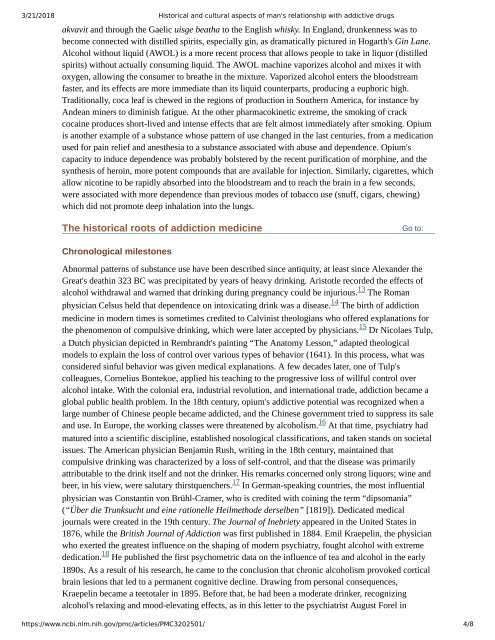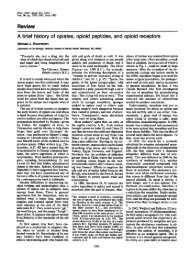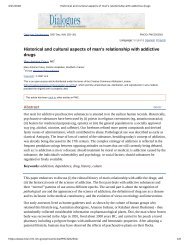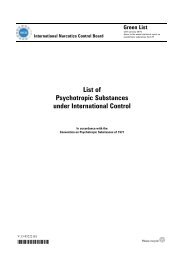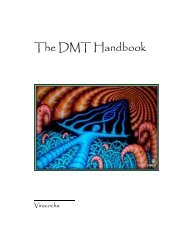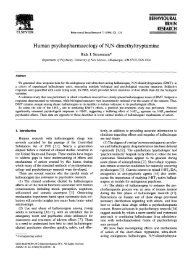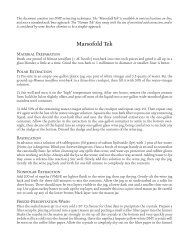Historical and cultural aspects of man's relationship with addictive drugs
Historical and cultural aspects of man's relationship with addictive drugs
Historical and cultural aspects of man's relationship with addictive drugs
Create successful ePaper yourself
Turn your PDF publications into a flip-book with our unique Google optimized e-Paper software.
3/21/2018 <strong>Historical</strong> <strong>and</strong> <strong>cultural</strong> <strong>aspects</strong> <strong>of</strong> <strong>man's</strong> <strong>relationship</strong> <strong>with</strong> <strong>addictive</strong> <strong>drugs</strong><br />
akvavit <strong>and</strong> through the Gaelic uisge beatha to the English whisky. In Engl<strong>and</strong>, drunkenness was to<br />
become connected <strong>with</strong> distilled spirits, especially gin, as dramatically pictured in Hogarth's Gin Lane.<br />
Alcohol <strong>with</strong>out liquid (AWOL) is a more recent process that allows people to take in liquor (distilled<br />
spirits) <strong>with</strong>out actually consuming liquid. The AWOL machine vaporizes alcohol <strong>and</strong> mixes it <strong>with</strong><br />
oxygen, allowing the consumer to breathe in the mixture. Vaporized alcohol enters the bloodstream<br />
faster, <strong>and</strong> its effects are more immediate than its liquid counterparts, producing a euphoric high.<br />
Traditionally, coca leaf is chewed in the regions <strong>of</strong> production in Southern America, for instance by<br />
Andean miners to diminish fatigue. At the other pharmacokinetic extreme, the smoking <strong>of</strong> crack<br />
cocaine produces short-lived <strong>and</strong> intense effects that are felt almost immediately after smoking. Opium<br />
is another example <strong>of</strong> a substance whose pattern <strong>of</strong> use changed in the last centuries, from a medication<br />
used for pain relief <strong>and</strong> anesthesia to a substance associated <strong>with</strong> abuse <strong>and</strong> dependence. Opium's<br />
capacity to induce dependence was probably bolstered by the recent purification <strong>of</strong> morphine, <strong>and</strong> the<br />
synthesis <strong>of</strong> heroin, more potent compounds that are available for injection. Similarly, cigarettes, which<br />
allow nicotine to be rapidly absorbed into the bloodstream <strong>and</strong> to reach the brain in a few seconds,<br />
were associated <strong>with</strong> more dependence than previous modes <strong>of</strong> tobacco use (snuff, cigars, chewing)<br />
which did not promote deep inhalation into the lungs.<br />
The historical roots <strong>of</strong> addiction medicine<br />
Go to:<br />
Chronological milestones<br />
Abnormal patterns <strong>of</strong> substance use have been described since antiquity, at least since Alex<strong>and</strong>er the<br />
Great's deathin 323 BC was precipitated by years <strong>of</strong> heavy drinking. Aristotle recorded the effects <strong>of</strong><br />
13<br />
alcohol <strong>with</strong>drawal <strong>and</strong> warned that drinking during pregnancy could be injurious. The Roman<br />
14<br />
physician Celsus held that dependence on intoxicating drink was a disease. The birth <strong>of</strong> addiction<br />
medicine in modern times is sometimes credited to Calvinist theologians who <strong>of</strong>fered explanations for<br />
15<br />
the phenomenon <strong>of</strong> compulsive drinking, which were later accepted by physicians. Dr Nicolaes Tulp,<br />
a Dutch physician depicted in Rembr<strong>and</strong>t's painting “The Anatomy Lesson,” adapted theological<br />
models to explain the loss <strong>of</strong> control over various types <strong>of</strong> behavior (1641). In this process, what was<br />
considered sinful behavior was given medical explanations. A few decades later, one <strong>of</strong> Tulp's<br />
colleagues, Cornelius Bontekoe, applied his teaching to the progressive loss <strong>of</strong> willful control over<br />
alcohol intake. With the colonial era, industrial revolution, <strong>and</strong> international trade, addiction became a<br />
global public health problem. In the 18th century, opium's <strong>addictive</strong> potential was recognized when a<br />
large number <strong>of</strong> Chinese people became addicted, <strong>and</strong> the Chinese government tried to suppress its sale<br />
16<br />
<strong>and</strong> use. In Europe, the working classes were threatened by alcoholism. At that time, psychiatry had<br />
matured into a scientific discipline, established nosological classifications, <strong>and</strong> taken st<strong>and</strong>s on societal<br />
issues. The American physician Benjamin Rush, writing in the 18th century, maintained that<br />
compulsive drinking was characterized by a loss <strong>of</strong> self-control, <strong>and</strong> that the disease was primarily<br />
attributable to the drink itself <strong>and</strong> not the drinker. His remarks concerned only strong liquors; wine <strong>and</strong><br />
17<br />
beer, in his view, were salutary thirstquenchers. In German-speaking countries, the most influential<br />
physician was Constantin von Brühl-Cramer, who is credited <strong>with</strong> coining the term “dipsomania”<br />
(“Über die Trunksucht und eine rationelle Heilmethode derselben” [1819]). Dedicated medical<br />
journals were created in the 19th century. The Journal <strong>of</strong> Inebriety appeared in the United States in<br />
1876, while the British Journal <strong>of</strong> Addiction was first published in 1884. Emil Kraepelin, the physician<br />
who exerted the greatest influence on the shaping <strong>of</strong> modern psychiatry, fought alcohol <strong>with</strong> extreme<br />
18<br />
dedication. He published the first psychometric data on the influence <strong>of</strong> tea <strong>and</strong> alcohol in the early<br />
1890s. As a result <strong>of</strong> his research, he came to the conclusion that chronic alcoholism provoked cortical<br />
brain lesions that led to a permanent cognitive decline. Drawing from personal consequences,<br />
Kraepelin became a teetotaler in 1895. Before that, he had been a moderate drinker, recognizing<br />
alcohol's relaxing <strong>and</strong> mood-elevating effects, as in this letter to the psychiatrist August Forel in<br />
https://www.ncbi.nlm.nih.gov/pmc/articles/PMC3202501/ 4/8


